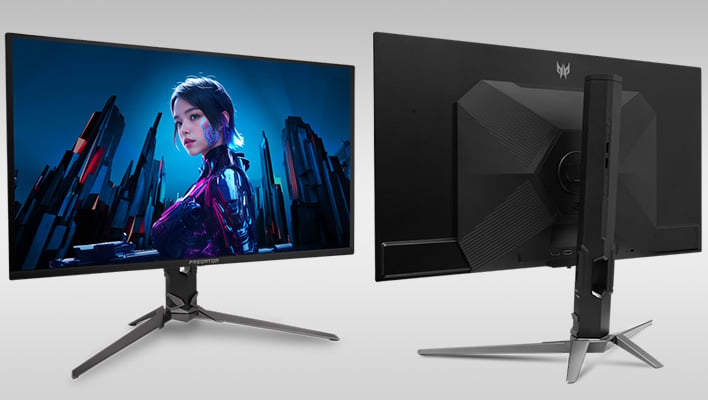Slowly but surely,
your options for buying a gaming monitor equipped with a cutting-edge quantum dot organic light-emitting diode (QD-OLED) panel are
expanding.The latest models to enter the fray are a couple of Acer Predator SKUs, those being the Predator X32 X2 and Predator X27U X1. We bet you can guess the screen sizes of each, based on the model names.
If not, let us decode them for you. The Predator X32 X2 is built around a 32-inch (technically, 31.5 inches) QD-OLED panel with a 3840x2160 resolution and fast 240Hz refresh rate (via either HDMI or DisplayPort). It also features a nearly non-existent 0.03ms gray-to-gray response time (a strength of OLED in general), along a 1,500,000:1 dynamic contrast ratio, an eye-searing 1,000 nits peak brightness rating (to make HDR content really pop), and 99% coverage of the DCI-P3 color space.
Notable certifications include FreeSync Premium Pro and VESA's DisplayHDR True Black 400 badge. There's no mention of NVIDIA G-SYNC compatibility, so we'll have to wait for it to show up in the wild to see if it can play nice with G-SYNC (the official compatibility badge is not necessarily a requisite).
It also boasts a pair of 2W speakers, which you'll likely never use unless your headset or desktop speakers give up the ghost. As for the input options, you're looking at a pair of HDMI 2.1 ports, a single DisplayPort 1.4 input, and a 3.5mm audio-out jack.
Acer's other new QD-OLED display is the Predator X27U X1, which features a 26.1-inch panel with a 2560x1440 resolution. Otherwise, the specs are identical to its bigger sibling, including the same 240Hz refresh rate, the same FreeSync Premium Pro and DisplayHDR True Black 400 certifications, and on down the list (including the same input options).
Beyond the physical size and resolution, pricing is where
Acer's new QD-OLED monitors diverge. The Predator X32 X2 will cost $999.99 when it releases in June, while the Predator X27U X1 will carry a $599.99 MSRP, with availability also in June.
One sticking point is Acer's warranty terms. Acer offers a three-year warranty on its OLED monitors for hardware defects, but as a
company rep plainly states on a Best Buy product page (for a different Predator QD-OLED monitor), it "does not covered burned-in images."
The good news is, burn-in is less of an issue these days, compared to the early days of OLED, as this
one-year stress test underscores. It's not a non-existent risk, though. Furthermore, much of the competition have
updated their OLED warranties to specifically include burn-in, so it's disappointing that Acer has yet to do the same.

